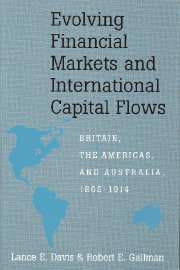 Evolving Financial Markets and International Capital Flows
Evolving Financial Markets and International Capital Flows Book contents
- Frontmatter
- Contents
- 1 Institutional invention and innovation: Foreign capital transfers and the evolution of the domestic capital markets in four frontier countries: Argentina, Australia, Canada, and the United States, 1865–1914
- 2 The United Kingdom
- 3 International capital movements, domestic capital markets, and American economic growth, 1865–1914
- 4 Domestic savings, international capital flows, and the evolution of domestic capital markets: The Canadian experience
- 5 Domestic saving, international capital flows, and the evolution of domestic capital markets: The Australian experience
- 6 Argentine savings, investment, and economic growth before World War I
- 7 Lessons from the past: International financial flows and the evolution of capital markets, Britain and Argentina, Australia, Canada, and the United States before World War I
- 8 Skipping ahead: The evolution of the world's finance markets 1914–1990 – A brief sketch
- 9 Lessons from the past
- Bibliography
- Index
1 - Institutional invention and innovation: Foreign capital transfers and the evolution of the domestic capital markets in four frontier countries: Argentina, Australia, Canada, and the United States, 1865–1914
Published online by Cambridge University Press: 18 August 2009
- Frontmatter
- Contents
- 1 Institutional invention and innovation: Foreign capital transfers and the evolution of the domestic capital markets in four frontier countries: Argentina, Australia, Canada, and the United States, 1865–1914
- 2 The United Kingdom
- 3 International capital movements, domestic capital markets, and American economic growth, 1865–1914
- 4 Domestic savings, international capital flows, and the evolution of domestic capital markets: The Canadian experience
- 5 Domestic saving, international capital flows, and the evolution of domestic capital markets: The Australian experience
- 6 Argentine savings, investment, and economic growth before World War I
- 7 Lessons from the past: International financial flows and the evolution of capital markets, Britain and Argentina, Australia, Canada, and the United States before World War I
- 8 Skipping ahead: The evolution of the world's finance markets 1914–1990 – A brief sketch
- 9 Lessons from the past
- Bibliography
- Index
Summary
Introduction
History and current events
No one believes that history repeats itself exactly, but many economic historians must have nodded knowingly when they opened their morning newspapers on February 27, 1995. On that day newspapers throughout the world reported that the House of Baring – one of the world's oldest private banks – had gone into bankruptcy. Over one hundred years earlier, in 1890, Barings had also teetered on the verge of bankruptcy. The cases are remarkably similar. Not only did the two crises involve the same institution, but in both cases Barings was involved in financial operations in the less-developed world. In 1890 it was Latin America, particularly Argentina and Uruguay. One hundred and five years later the newspapers reported that Barings was a “strong niche player in the emerging markets of Asia, Latin America, Africa and Eastern Europe.” Moreover, despite the passage of time and the growth in the size of the British economy, the magnitudes of the potential losses, then and now, are not dissimilar. In 1890, £17.25 million was sufficient to cover Barings potential liabilities; in today's dollars that figure amounts to just over $850 million. In 1995, if the press is to be believed, the funds required to save “the world's oldest private bank” fell in the $950 million to $1.27 billion range.
- Type
- Chapter
- Information
- Evolving Financial Markets and International Capital FlowsBritain, the Americas, and Australia, 1865–1914, pp. 1 - 49Publisher: Cambridge University PressPrint publication year: 2001


